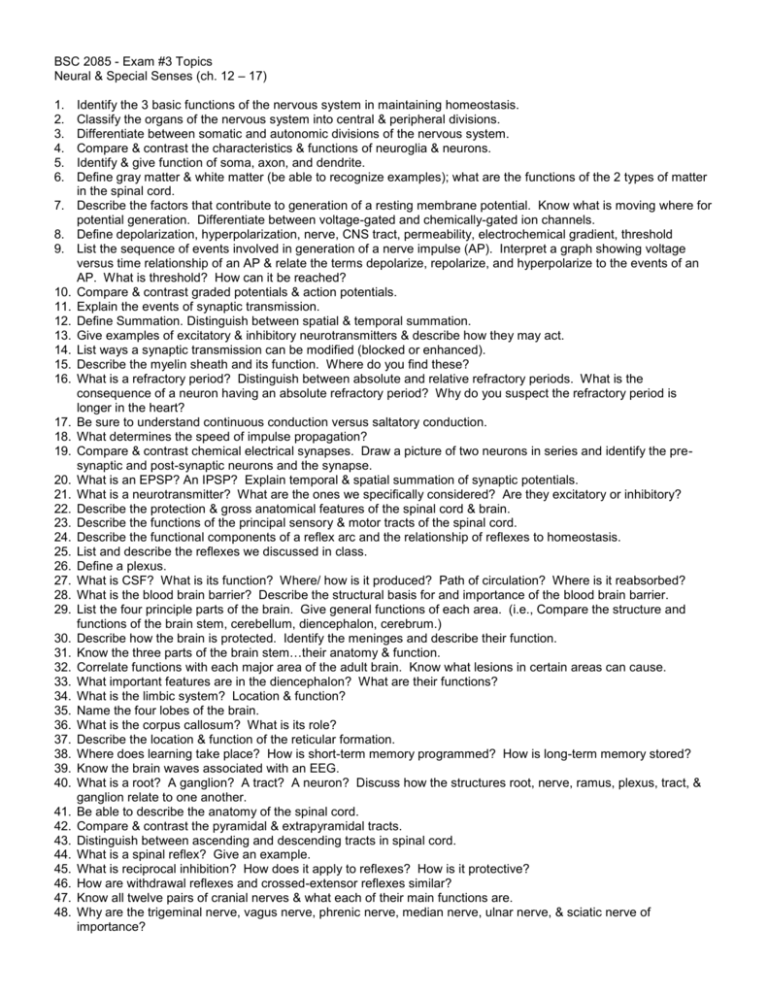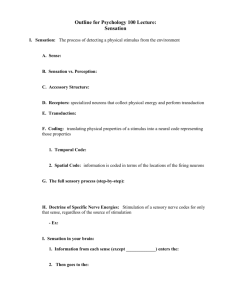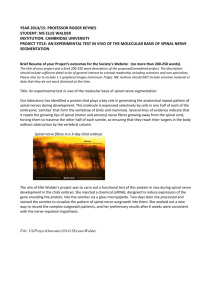exam3_F08
advertisement

BSC 2085 - Exam #3 Topics Neural & Special Senses (ch. 12 – 17) 1. 2. 3. 4. 5. 6. 7. 8. 9. 10. 11. 12. 13. 14. 15. 16. 17. 18. 19. 20. 21. 22. 23. 24. 25. 26. 27. 28. 29. 30. 31. 32. 33. 34. 35. 36. 37. 38. 39. 40. 41. 42. 43. 44. 45. 46. 47. 48. Identify the 3 basic functions of the nervous system in maintaining homeostasis. Classify the organs of the nervous system into central & peripheral divisions. Differentiate between somatic and autonomic divisions of the nervous system. Compare & contrast the characteristics & functions of neuroglia & neurons. Identify & give function of soma, axon, and dendrite. Define gray matter & white matter (be able to recognize examples); what are the functions of the 2 types of matter in the spinal cord. Describe the factors that contribute to generation of a resting membrane potential. Know what is moving where for potential generation. Differentiate between voltage-gated and chemically-gated ion channels. Define depolarization, hyperpolarization, nerve, CNS tract, permeability, electrochemical gradient, threshold List the sequence of events involved in generation of a nerve impulse (AP). Interpret a graph showing voltage versus time relationship of an AP & relate the terms depolarize, repolarize, and hyperpolarize to the events of an AP. What is threshold? How can it be reached? Compare & contrast graded potentials & action potentials. Explain the events of synaptic transmission. Define Summation. Distinguish between spatial & temporal summation. Give examples of excitatory & inhibitory neurotransmitters & describe how they may act. List ways a synaptic transmission can be modified (blocked or enhanced). Describe the myelin sheath and its function. Where do you find these? What is a refractory period? Distinguish between absolute and relative refractory periods. What is the consequence of a neuron having an absolute refractory period? Why do you suspect the refractory period is longer in the heart? Be sure to understand continuous conduction versus saltatory conduction. What determines the speed of impulse propagation? Compare & contrast chemical electrical synapses. Draw a picture of two neurons in series and identify the presynaptic and post-synaptic neurons and the synapse. What is an EPSP? An IPSP? Explain temporal & spatial summation of synaptic potentials. What is a neurotransmitter? What are the ones we specifically considered? Are they excitatory or inhibitory? Describe the protection & gross anatomical features of the spinal cord & brain. Describe the functions of the principal sensory & motor tracts of the spinal cord. Describe the functional components of a reflex arc and the relationship of reflexes to homeostasis. List and describe the reflexes we discussed in class. Define a plexus. What is CSF? What is its function? Where/ how is it produced? Path of circulation? Where is it reabsorbed? What is the blood brain barrier? Describe the structural basis for and importance of the blood brain barrier. List the four principle parts of the brain. Give general functions of each area. (i.e., Compare the structure and functions of the brain stem, cerebellum, diencephalon, cerebrum.) Describe how the brain is protected. Identify the meninges and describe their function. Know the three parts of the brain stem…their anatomy & function. Correlate functions with each major area of the adult brain. Know what lesions in certain areas can cause. What important features are in the diencephalon? What are their functions? What is the limbic system? Location & function? Name the four lobes of the brain. What is the corpus callosum? What is its role? Describe the location & function of the reticular formation. Where does learning take place? How is short-term memory programmed? How is long-term memory stored? Know the brain waves associated with an EEG. What is a root? A ganglion? A tract? A neuron? Discuss how the structures root, nerve, ramus, plexus, tract, & ganglion relate to one another. Be able to describe the anatomy of the spinal cord. Compare & contrast the pyramidal & extrapyramidal tracts. Distinguish between ascending and descending tracts in spinal cord. What is a spinal reflex? Give an example. What is reciprocal inhibition? How does it apply to reflexes? How is it protective? How are withdrawal reflexes and crossed-extensor reflexes similar? Know all twelve pairs of cranial nerves & what each of their main functions are. Why are the trigeminal nerve, vagus nerve, phrenic nerve, median nerve, ulnar nerve, & sciatic nerve of importance? 49. Name the various neurotransmitters in brain. What do they do? 50. How can receptors be classified? Describe each of the following receptors and indicate what sensation it detects & give an example of where it can be found in the body: nociceptors, thermoreceptors, mechanoreceptors (both proprioceptors & baroceptors), chemoceptors, and photoceptors. 51. Be able to list the different types of encapsulated dendritic endings and what they are receptors for? 52. What is adaptation? What receptors are not prone to this? 53. Compare and contrast somatic & autonomic systems. 54. Describe the anatomy of the ANS. What is outflow? Discuss the 2 divisions of the ANS & the general physiological roles of each. 55. Describe how the ANS works. What is dual innervation? 56. Compare the sympathetic and parasympathetic divisions of the autonomic nervous system in terms of anatomy, physiology, and neurotransmitters released. 57. Describe the major parasympathetic and/ or sympathetic physiological effects on target organs. 58. Differentiate between cholinergic and adrenergic nerve fibers & discuss the physiological interactions of transmitters released by these neurons with specific cholinergic & anrenergic receptor subtypes. 59. Describe the various neurotransmitters and receptors involved in autonomic responses. 60. Describe the components of an autonomic reflex. 61. Taste: name the five primary tastes, how we taste; location and structure of taste buds. 62. Eye: anatomy 63. Name 3 layers & their characteristics (sclera/ cornea, choroid, retina) 64. Identify and give functions of: canal of Schlemm, ciliary body, ciliary muscle, iris, cavities and ant and post chamber 65. Humors: aqueous – where made, where does it leave eye 66. Glaucoma: what is it? How is the canal of Schlemm involved? 67. Vitreous humor…where found? 68. Lens characteristics 69. Retina: what is it? What happens here? What is special about it? 70. Optic disc and macula and fovea…what are they? What do they do? 71. Name the 6 extrinsic eye muscles (on practical, not written exam) 72. Name 2 intrinsic eye muscles (iris, ciliary…innervation, which parts are symp, which are parasymp?) 73. Eyelids = palpebrae or blepharo (ptosis = droop) 74. Corner = canthus 75. Lining = conjunctiva, irritation = ?? 76. Lacrimal apparatus: how does it work? Why does one’s nose run when one cries? 77. Physiology: define refraction (where does most refraction take place? The lens? The air-cornea surface? 78. How do we increase the power of a lens? 79. Know the different ways in which the eyes accommodate for seeing things at varying distances (all of those pictures…know them, be able to explain them)…i.e. rays form a near object are diverging, they therefore focus farther back 80. Explain problem and correction for : hyperopia, myopia, astigmatism, presbyopia 81. Retina and receptors: rods v. cones, fovea v. peripheral retina…which provides best color (dim light vs bright light acuity…why?) Compare/ contrast the function of rods & cones in vision. 82. Fovea has best acuity of any part of retina…why? 83. If you look directly at a dim star, frequently it will disappear. Why? Outside fovea – colors not as bright – why? What colors can you see by moonlight? What is the effect of (bright) light on rhodopsin? 84. Explain dark adaptation and light adaptation, relate this to entering and leaving a dark theater on a bright day 85. What does a person see in his or her blind spot? What does a person with a visual field defect see in his or her blind fields? 86. Ear: Anatomy—external, middle, inner 87. Describe how the various structures of the outer, middle, and inner ear function in hearing 88. Describe the sound conduction pathway from the auricle to the fluids of the inner ear & the path of nerve impulses from the spiral organ to various parts of the brain. 89. How is pitch (freq.) encoded on the basilar membrane? 90. How is intensity encoded on the basilar membrane? 91. Where is the defect in conduction deafness, nerve deafness? 92. What does the macula of utricle or saccule detect? 93. What does the semicircular canal detect? 94. What is the function of the Eustachian tube? 95. Distinguish between static and dynamic equilibrium. 96. Suppose a pilot was to spin for a long time (1 min) then release he controls and the plane resumed straight and level flight. What would his semicircular canals be telling him about his state (spinning or not spinning)? P.S. this kills a lot of amateur pilots. 97. Explain how odorants activate the olfactory receptors. 98. Describe the path of nerve impulses from the olfactory receptors to various parts of the brain.








